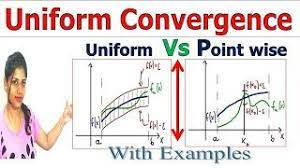Uniform vs Pointwise Convergence

Uniform vs Pointwise
Pointwise and uniform convergenceThe aim here is to show some videos illustrating the difference between pointwise and uniformly convergent sequences of functions.Example 0:  at the point just gives the sequence
at the point just gives the sequence  . This viewpoint (ie, sequences arising from fixed x values) is shown in the left picture below. However we normally consider the sequence of functions as
. This viewpoint (ie, sequences arising from fixed x values) is shown in the left picture below. However we normally consider the sequence of functions as  increases, and this is
shown in the figure below right.
increases, and this is
shown in the figure below right.

 Example 1:
Example 1:  in blue converges pointwise (and in fact uniformly) to
in blue converges pointwise (and in fact uniformly) to  in orange
below.
in orange
below.

 Example 1:
Example 1: 
Explanation w/ example
Uniform and pointwise convergence are two different ways to describe the behavior of a sequence of functions converging to a limiting function. Let's explain both concepts using an example.
Example: Consider the sequence of functions defined on the interval [0, 1].
1. Pointwise Convergence:
Pointwise convergence refers to the convergence of the individual function values at each point in the domain as (n) approaches infinity.
For this example, pointwise convergence means that for each (x) in the interval [0, 1], we examine the behavior of fn(x) as (n) becomes very large.
fn(x) =
As (n) increases, the value of fn(x) approaches 0 for any fixed (x) in the interval [0, 1]. It means that as (n) becomes large, each function fn(x) approaches the zero function.
2. Uniform Convergence:
Uniform convergence refers to the convergence of the entire sequence of functions as a whole, rather than just the individual function values. It means that the difference between fn(x) each and the limiting function (f(x)) becomes arbitrarily small for all points in the domain as (n) approaches infinity.
For this example, the limiting function is (f(x) = 0) (the zero function).
We say that the sequence of functions fn(x) = converges uniformly to the zero function (f(x) = 0) on the interval [0, 1] if, for any >0, there exists an N such that for all (n > N) and for all (x) in [0, 1], the inequality < holds.
In this example, the sequence of functions fn(x) = converges uniformly to the zero function on [0, 1] because for any > 0, we can always choose . Then, for all (n > N) and for all (x) in [0, 1], we have:
So, the difference between fn(x) and (f(x)) becomes arbitrarily small for all (x) in the interval [0, 1] as (n) becomes large.
In summary, pointwise convergence considers the behavior of individual function values at each point, while uniform convergence ensures that the entire sequence of functions approaches the limiting function in a uniform manner across the entire domain. In this example, the sequence of functions fn(x) = converges pointwise to the zero function (f(x) = 0), but it converges uniformly to the same zero function on the interval [0, 1].